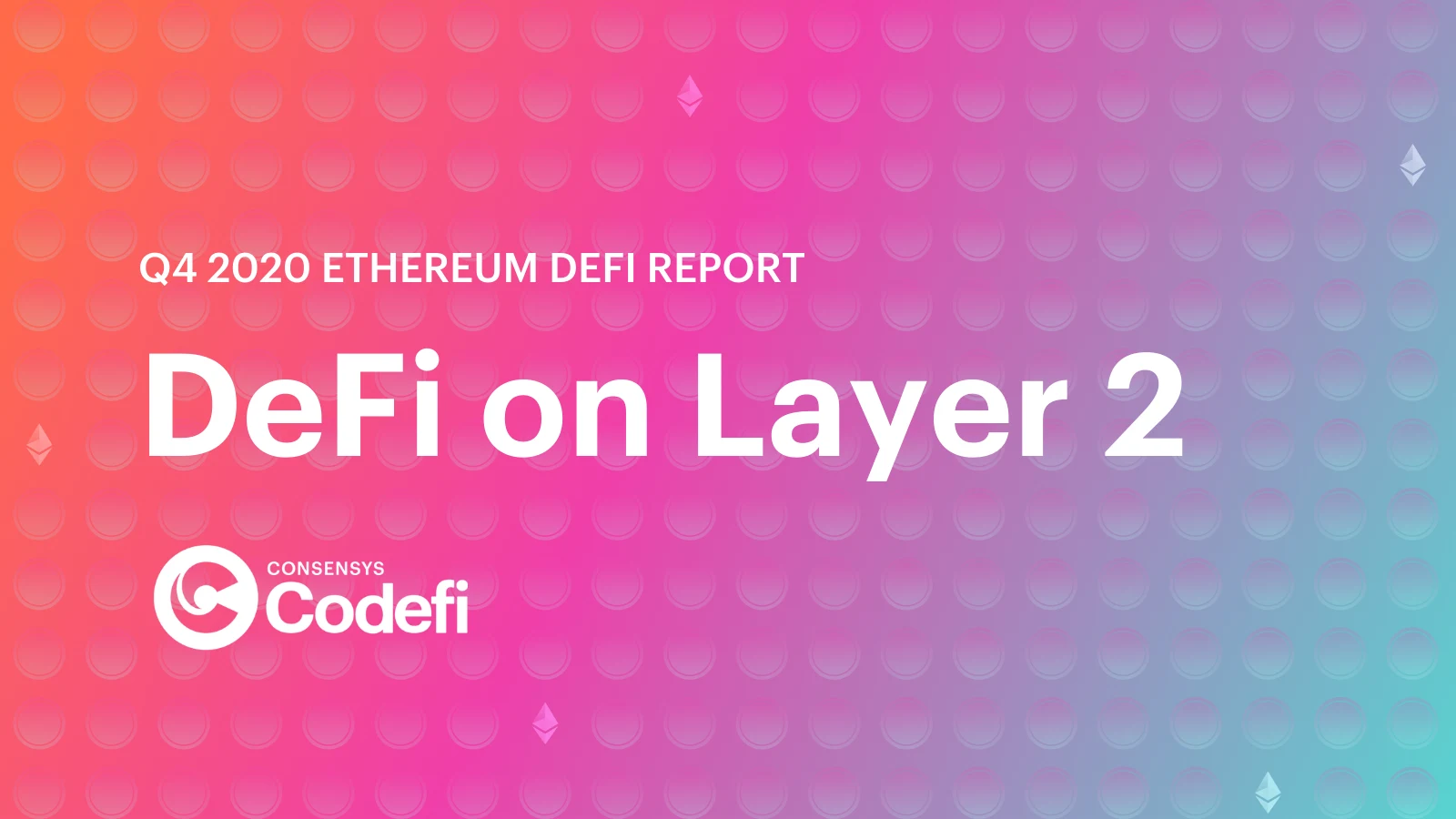This is part of a series of articles from Consensys Codefi’s Q4 2020 Ethereum DeFi Report. Download the full report to learn more about token standards for assets and payments, NFT marketplaces, social and community tokens, flash loans, wrapped Bitcoin and Filecoin, lending projects and more.
Even as Ethereum 2.0 steadily progresses, the cost to interact with DeFi protocols on Ethereum is becoming prohibitively expensive. The race is now on for developers and users to start using Layer 2 protocols (L2s) that connect with Ethereum in order to swap, lend, borrow, and provide liquidity. The good news is that the Eth2 roadmap will rely on rollups, a type of L2 method for scaling. It also means that the most popular DeFi protocols today are beginning to test their applications on L2s, with some already functional for swapping ERC-20 tokens and $250 million locked up in liquidity.
Rollups: Testing with DeFi Applications
If you heeded our advice at the beginning of the report and tested out a few of these DeFi protocols, you might have been taken aback by the gas costs to execute a trade, mint an NFT, or interact with a protocol. While the community anticipates a more scalable and cheaper Eth2, Layer 2 protocols batch transactions before attesting to the Ethereum mainnet.
One such Layer 2 technology is rollups, which take much of the burden of computation and storage out of the blockchain and use the chain just enough to benefit from its security guarantees. Loopring’s zkRollup solution now holds more than $250 million (gaining more than $150m in the first month and a half of 2021).

Rollups are also starting to attract gas-guzzling DeFi protocols. The derivatives platform, Synthetix recently announced that SNX staking would go live on Optimism, which uses optimistic rollups. Their demo demonstrated a decrease in gas costs by 143 times (!), and a transaction confirmation time of 0.3 seconds.
Uniswap demonstrated the user experience improvements that are possible with Optimism. Gas costs for swaps decreased by 10-100 times, and transactions were confirmed in a lightning-fast 139 milliseconds. You can actually test it here.

Optimism recently launched their Optimistic Virtual Machine (OVM) — the backend for Optimistic Rollup which enables full Ethereum Virtual Machine (EVM) support, and also supports all existing Ethereum dev tools and libraries including Solidity, Vyper, Truffle, Open Zeppelin, MetaMask, and Web3.js among others.
As Hayden Adams put it,
"Imagine not needing to make any changes to your solidity smart contracts to have a dApp work natively on an Ethereum L2 with security from Ethereum, massive scaling, no data availability issues, and synchronous interoperability with other DAPPs on L2."
Rollups Are Essential To Eth2
Rollups will play an essential role in the Eth2 roadmap. Right now, the Ethereum Virtual Machine (EVM) uses gas prices to limit the amount of data, or state, that is stored on the open distributed network. The EVM is powerful, but it is intentionally being constrained. Rollups solve this by managing state outside of the core EVM protocol. This may actually be a better position for Eth2, because according to Vitalik Buterin, "sharding data availability is much safer than sharding EVM computation."
With the Eth2 research community moving toward the rollup centric roadmap, shard chains on Eth2 will only need to take care of ordering data. And perhaps most important for the experience of Ethereum users today, rollups mean that the move to Proof-of-Stake will be minimally disruptive to the existing libraries, tooling, and dApps today. Check out Ben Edgington's recent post on how rollups fit into the Eth2 roadmap.
What about other Layer 1 blockchain protocols?
With high gas fees on Ethereum, different types of blockchains may increasingly attempt to attract Ethereum-based DeFi applications. FTX, a popular crypto exchange in Hong Kong, decided to build its decentralized exchange called Serum on Solana. In November 2020, Serum generated $111 million in volume, significantly less than the $17 billion in volume on Ethereum-based DEXes in the same month, yet also not a negligible amount.
The 1inch.exchange-backed project, Mooniswap, also decided to go with the Near Protocol for its automated market maker (AMM) DEX. Sergej Kunz, the co-founder of 1inch, claimed, “By building on NEAR, we’ll be able to experiment with sharding and be prepared for the arrival of Ethereum 2.0.”
What about Binance Smart Chain (BSC)? Despite the total value locked growing rapidly in recent weeks, the BSC model can hardly be considered "decentralized finance." BSC only has a small number of validators in their Proof of Stake Authority consensus model, and it just so happens that Binance owns and operates all of them.
The network effects and technical investment in Ethereum are major reasons why more DeFi applications haven’t been quick to rewrite their smart contracts in a new language for a new protocol. It’s why so many crypto assets like Bitcoin and Filecoin are being tokenized on Ethereum, a trend we expect will accelerate in 2021. Though growing quickly, the overall DeFi market size is comparably small compared to other commercial and financial markets. Many of these sophisticated new types of financial products and services seek initial liquidity from the groups of traders already familiar with Ethereum-based crypto wallets like MetaMask, a strong track record of network uptime, robust auditing tools and services, and on-chain data feeds and oracles.
Interoperability between blockchains remains an active research space. We think the gravity of Ethereum's activity will push more activity to Layer 2 protocols already interoperable with Ethereum. Additionally, since Layer 2 technologies like rollups are becoming incorporated in the Eth2 roadmap, DeFi applications might be better off waiting to see how research teams figure out cross-rollup data execution and consensus before venturing too far from widely-adopted Ethereum standards.
